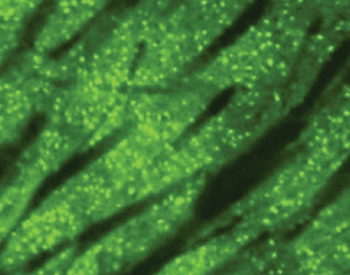Tracing Technique Untangles Brain Circuit Networks
By LabMedica International staff writers
Posted on 10 Jul 2013
High-resolution mapping has uncovered the architecture of neural circuits leading to the basal ganglia, which could promote research into disorders such as Parkinson’s disease (PD) and Huntington’s disease.Posted on 10 Jul 2013
Researchers at the Gladstone Institutes (San Francisco, CA, USA) and the Salk Institute (San Diego, CA, USA) combined mouse models with a sophisticated tracing technique, known as the monosynaptic rabies virus (MRV) system, to assemble brain-wide maps of the striatum of neurons that connect with the basal ganglia, integrating information from multiple brain regions to shape motor learning. The two major projection cell types in the striatum target different downstream basal ganglia targets and have opposing effects on motivated behavior, yet differential innervation of these neuronal subtypes is not well understood.

Image: Neurons in the basal ganglia (Photo courtesy of Anatol Kreitzer, PhD, Gladstone Institutes).
To examine whether input specificity provides a basis for information segregation, the researchers used a MRV system to generate brain-wide maps of neurons that form synapses with direct- or indirect-pathway striatal projection neurons. They found that sensory cortical and limbic structures mostly innervated the direct pathway, whereas motor cortex structures preferentially targeted the indirect pathway. The researchers also found that thalamostriatal input, dopaminergic input, and input from specific cortical layers were similar in both pathways. The study was published on June 26, 2013, in Neuron.
“Taming and harnessing the rabies virus is ingenious in the exquisite precision that it offers compared with previous methods, which were messier with a much lower resolution,” said study coauthor Anatol Kreitzer, PhD, of the Gladstone Institutes. “We took the approach one step further by activating the tracer genetically, which ensures that it is only turned on in specific neurons in the basal ganglia. This is a huge leap forward technologically, as we can be sure that we’re following only the networks that connect to particular kinds of cells in the basal ganglia.”
“These initial results should be treated as a resource not only for decoding how this network guides the vast array of very distinct brain functions, but also how dysfunctions in different parts of this network can lead to different neurological conditions,” added coauthor Edward Callaway, PhD, of the Salk Institute. “If we can use the rabies virus system to pinpoint distinct network disruptions in distinct types of disease, we could significantly improve our understanding of these diseases’ underlying molecular mechanisms and get even closer to developing solutions for them.”
The MRV system, originally developed in 2007 and refined by Dr. Callaway and other researchers for targeting specific cell types in 2010, uses a modified version of the rabies virus to “infect” a brain region, which in turn targets and infects neurons that are connected to it. When the system was applied in genetic mouse models, the team could see specifically how sensory, motor, and reward structures in the brain connected to medium spiny neurons (MSNs) in the basal ganglia.
Related Links:
Gladstone Institutes
Salk Institute














